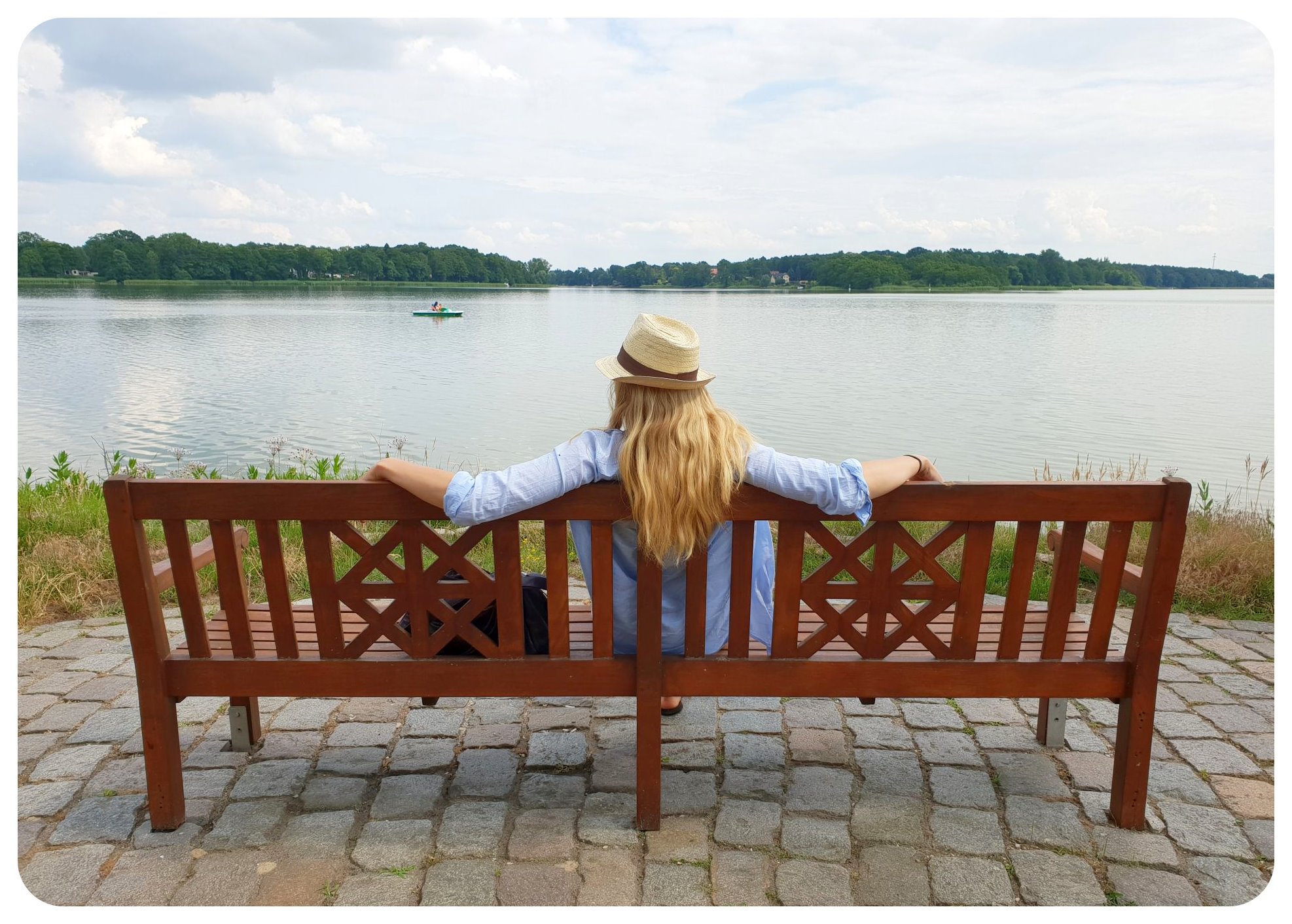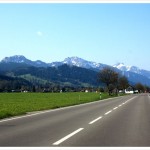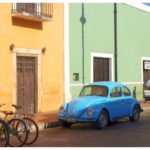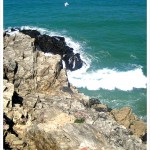Last Updated on May 15, 2023
Over the past few years, my visits to Germany have been looking pretty much the same every time I go: I stop in my hometown to my family, I stop in Berlin because I can’t get enough of the city, and I visit friends in Cologne and Munich. But what about the rest of Germany? Even though I spent quite a bit of time traveling Germany when I was younger and still living in Europe, there are still plenty of places I have yet to visit. On top of my wish list: Spreewald (a biosphere reserve consisting of wetlands and forests southeast of Berlin), a northern Germany road trip including the cities of Bremen and Bremerhaven, and Lübeck, which is famous for its brick Gothic architecture, and the coastal region of East Frisia), and a southern Germany road trip along the Romantic Road which covers a bunch of fairytale-like towns in Southern Germany.
When my friend suggested we could meet up in Germany for a few days during my last visit, and asked me to show her Germany beyond Berlin, I immediately started researching possible trips. A quick search for car rentals in Germany revealed that a rental car would cost us less than $25 per day, and that was for a pick-up right in the center of Berlin (note that rental pick-up at one of the airports would’ve cost around $24 per day), which is an amazing rate. Plus, it meant we could bring my favorite furry travel companion along. I decided to introduce my friend to Germany’s nautical side and mapped out a Northern Germany road trip route that is perfect if you have a week to spend in Germany, but which can also be driven in five days. I wanted to include the famous Mecklenburg Lake Plateau, the Baltic Sea, at least one of Germany’s fairy tale castles, a grand Hanseatic city and a smaller town in the countryside.
I decided to introduce my friend to Germany’s nautical side and mapped out a Northern Germany road trip route that is perfect if you have a week to spend in Germany, but which can also be driven in five days. I wanted to include the famous Mecklenburg Lake Plateau, the Baltic Sea, at least one of Germany’s fairy tale castles, a grand Hanseatic city and a smaller town in the countryside.
This kind of trip definitely required a car, since several towns were small and not on the main bus routes (side note: the buses also take the major highways, instead of scenic byways), and taking the train would’ve meant connecting. I created a road trip that had a couple of stops en-route, meaning we would only spend a couple of hours or an afternoon there on the way to our final destination for the day – which is only possible if you have a car. Train and bus travel are solid options in Germany when you just travel from A to B, but to see more of the country and to get ‘off the beaten path’, you really need a vehicle. Luckily, car rentals in Germany are inexpensive and you can get a small rental starting at around $23 per day, or a medium-sized vehicle starting at around $25 per day. And did I mention renting a car meant I’d be able to bring a dog? 🙂
Here’s the map of our route (I excluded highways so that we would only drive scenic country roads):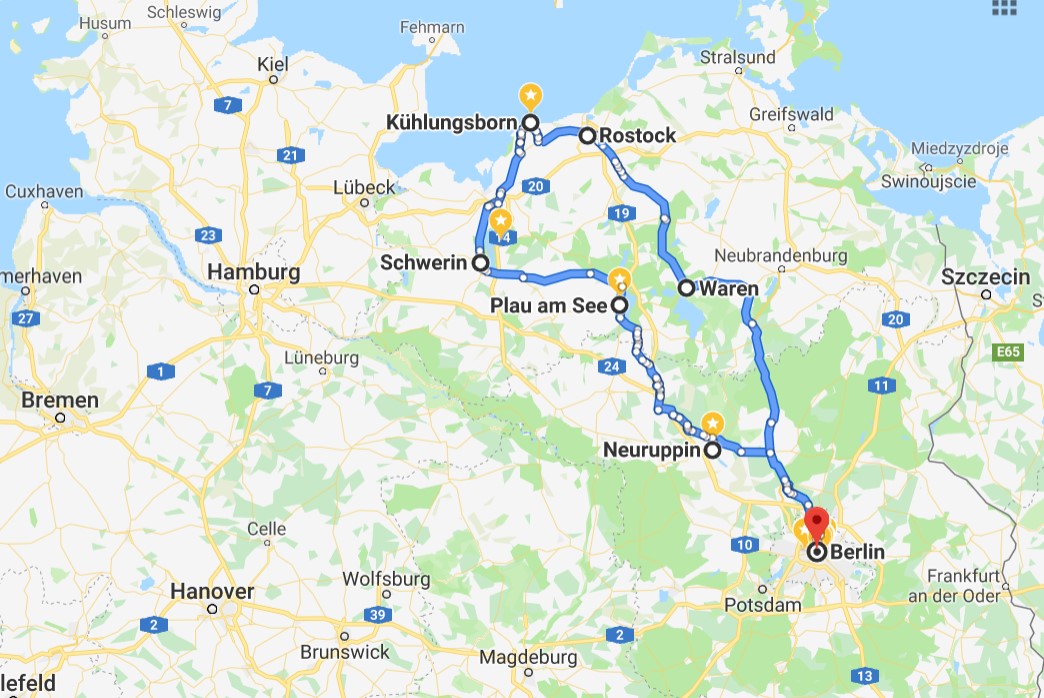
Read on for the highlights of this road trip through northern Germany and what not to miss in each of the places you drive through:
My Northern Germany Road Trip Itinerary
Berlin
Germany’s capital has so much to offer, you can easily spend an entire week just there. If you haven’t been yet, get an overview and learn about the comprehensive and complicated history of Berlin during both World War II and the division between East and West Germany on a free walking tour. Go for a bike ride in Tiergarten Park and on Tempelhof airfield, an abandoned airport turned park. Take in the city from above from either Victory Column (only €3, but 270 steps) or the observation deck on top of the Park Inn at Alexanderplatz, right across from the TV Tower (€4).
Eat Middle Eastern food while you’re wandering the streets of Berlin’s trendy Neukölln neighborhood and go flea market hopping on a weekend in the Prenzlauer Berg neighborhood (don’t miss Mauerpark for the flea market, street food and the largest karaoke event in Germany – every Sunday during the summer months – and the Sunday flea market at Arkonaplatz). Head to the East Side Gallery for fantastic murals, and go barhopping in the vibrant Friedrichshain neighborhood.
Check out my detailed guide to Berlin for more ideas on what to see and do.
Neuruppin
Drive: Berlin to Neuruppin: 80 kilometers / 50 miles – about 90 minutes
Suggested stop along the way: Sachsenhausen-Oranienburg, a Nazi concentration camp in Oranienburg just north of Berlin. The visit is a somber but educational experience.
Leave Berlin and drive north towards the lake district. Once you’ve left the city limits behind you, you’ll find yourself driving through lush green parkland and forests, along small rivers and canals. Neuruppin sits right on the shore of Ruppin Lake, and there is a beautiful trail along the lake. The town is known as a garrison town and was mainly built in Neoclassical style – the many pastel colored houses provide gorgeous photo opps. The remarkable minster Sankt Trinitatis, a historic church with adjacent monastery, was built in 1264 (the oldest building in Neuruppin) is the centerpiece of the small town.
If you’re a fan of sauna culture, plan in enough time for a visit to the thermal bath in Neuruppin which is the largest lake sauna for swimming in all of Germany. The views of the Ruppin Lake from the many different saunas are fabulous.
Plau Am See
Drive: Neuruppin to Plau Am See, 90 kilometers / 56 miles – about 90 minutes
The small town is the gateway to the Mecklenburg Lake Plateau, and its name translates to ‘Plau On The Lake’. The city was founded around 1235 and has a lovely historic Old Town with half-timbered houses that’s worth a stroll. The main sights include the historic church, the Neo-classical town hall, the ruins of Plau Castle, and a bridge that is vertically lifted every time a boat wants to pass through the channel below. There is also a historic water mill that dates to 1273.
Schwerin
Drive: Plau Am See to Schwerin, 73 kilometers / 45 miles – about 1 hour
You’ll drive through the picturesque lake district for about an hour before you reach Schwerin, the state capital of Mecklenburg-Vorpommern. The city is famous for its majestic palace, Schwerin Castle, which sits on an island in Lake Schwerin, one of several scenic lakes. Until 1918, the picture-perfect fairytale palace was a main residence of the dukes and grand dukes of Mecklenburg, and since 1990, it has been the seat of the state parliament.
Schwerin is the oldest city in Mecklenburg-Vorpommern (first mentioned in 1018) and has a well preserved Old Town, including the beautiful Schwerin Cathedral, built in Brick Gothic style (1260 – 1416).
Tip: If you don’t have time for an extended visit, I recommend a pit stop on your northern Germany road trip in Schwerin to see at least the stunning castle. 
Wismar / Kühlungsborn
Drive: Schwerin to Kühlungsborn, 70 kilometers / 44 miles – around 1 hour and 15 minutes
Recommended stop along the way: Wismar
If you have time, stop in Wismar, about halfway in between Schwerin and Kühlungsborn. It’ll add only 15 – 20 mins to the drive, but you’ll get to see the remarkable medieval buildings of Wismar’s well preserved Old Town, which is part of the shared UNESCO World Heritage site of Wismar and Stralsund (another city on the Baltic coast). Both Wismar and Schwerin were major trading centers of the Hanseatic League, a commercial and defensive confederation of merchant guilds and market towns in Northwestern and Central Europe, founded in the late 1100s.
As you drive towards Kühlungsborn you’ll enjoy lovely views of the countryside, little hamlets, forests, and eventually, the azure blue Baltic Sea.
Kühlungsborn is a famous German seaside resort on the Baltic Sea – the main attraction here is the 4 kilometer (2.5 miles) long beach promenade, one of the longest in Germany. There’s not much to do here beyond the beach, but that’s exactly why 3 million people flock to Kühlungsborn every year: to simply soak up some of the salty sea air, take a dip in the freezing cold Baltic Sea (the water temperature in the summer averages a cool 18°C / 64°F).
Spend a day lounging in a Strandkorb (a sheltered straw ‘beach basket’ seat typical for the seaside resorts along the Baltic Sea coast) on its long and wide sand beach. When you find yourself getting hungry, go for a stroll along the promenade and stop in one of the many seafood restaurants for the Catch of the Day.
If you want to be more active, rent bikes and ride along the ‘Kühlung’, the unique a forested ridge, part of a cycling route along the coast. Worth visiting are also nearby Heiligendamm, Germany’s very first seaside resort, and lighthouse Buk, built in 1878. The views over the surrounding area and the Baltic Sea from the top of the lighthouse are unrivaled.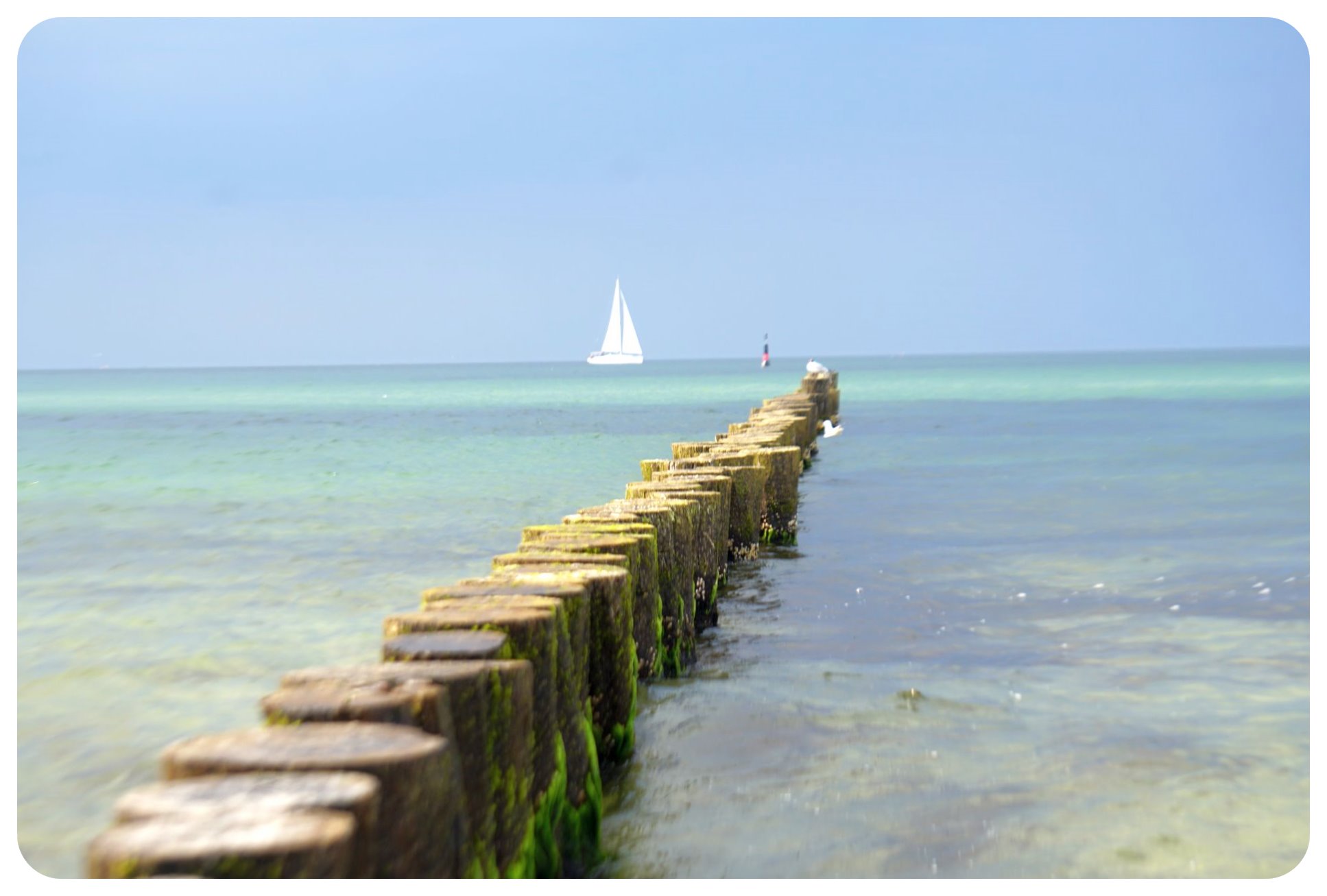
Rostock
Drive: Kühlungsborn to Rostock, 33 kilometers / 21 miles – about 40 minutes
Rostock is the largest city in the state of Mecklenburg Vorpommern and used to be the most significant member of the Hanseatic League (see above). The city celebrated its 800th (!) birthday in 2018 and is famous not only for its past as an important seaport in the Baltic Sea, but also its striking architecture (many buildings were built in Brick Gothic style, typical for the Hanseatic cities), several grand churches (dating to the 13th century), the impressive harbor and restored gable houses from the 15th and 16th centuries. You can even still see parts of the medieval city wall.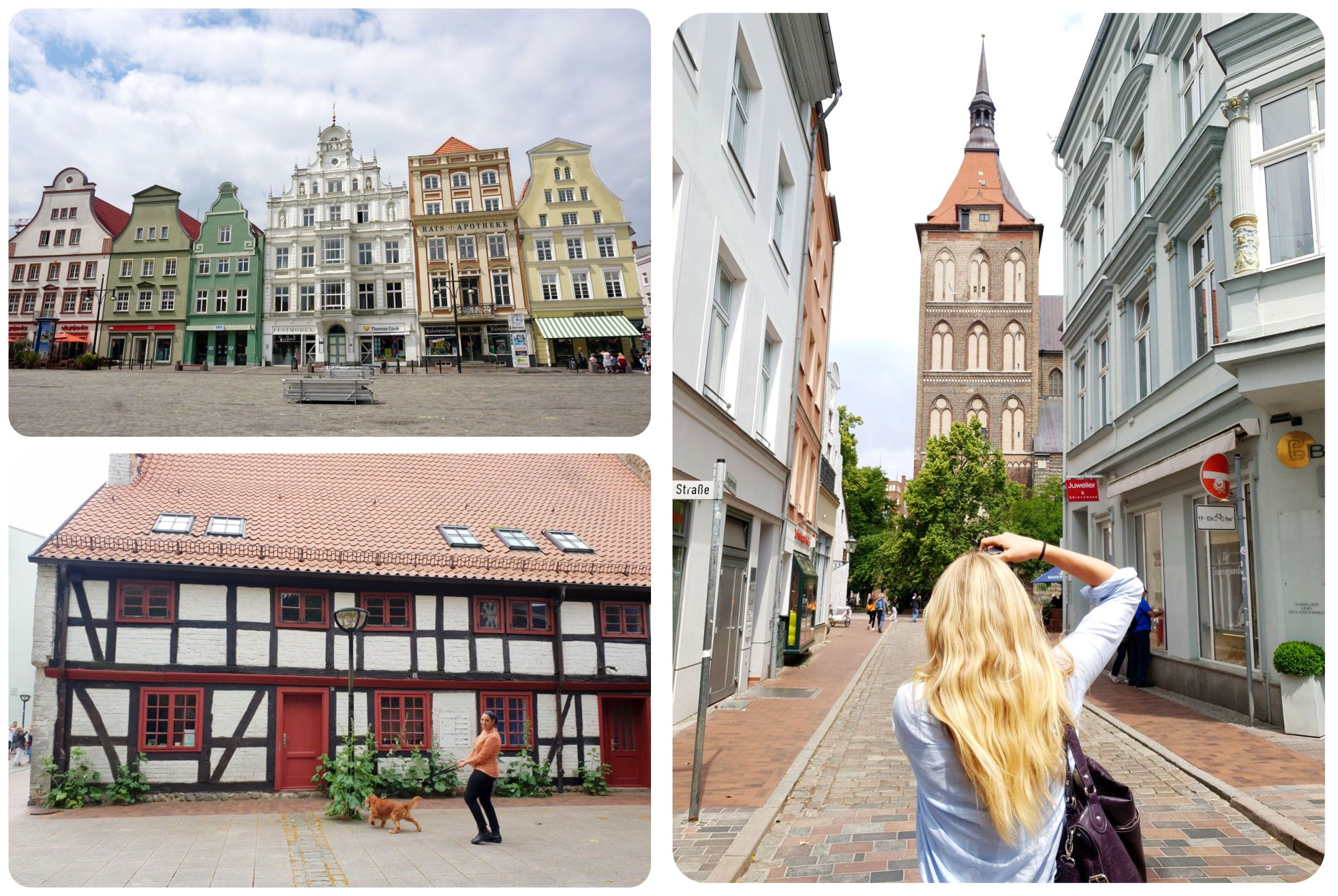
Warnemünde
Drive: Rostock to Warnemünde, 10 kilometers / 6 miles – about 12 minutes
If you have time, don’t miss nearby Warnemünde, which is a district of Rostock that is located right on the Baltic Sea (Rostock is further inland, connected to the Baltic Sea via the Unterwarnow, the estuary of the Warnow River). Warnemünde has managed to maintain the character of a small fishing village (population 8,400), despite having become a popular cruise ship destination.
The promenade is lined with colorful houses, hotels, restaurants and little shops, and the main canal, Alter Strom, is lined with beautiful boats. The historic lighthouse, built in 1898, is worth the climb (135 steps) for the glorious coastal vistas.
Tip: If you haven’t set the dates for your Northern Germany road trip yet, try to head to Rostock and Warnemünde during the second weekend in August, when Hanse Sail takes place. Hanse Sail is a huge maritime festival with up to 1..5 million visitors, celebrating maritime traditions and culture. Around 250 sailing ships of all types and sizes from different countries sail to Rostock for the festival – a truly unique spectacle. (If you’re planning to spend the night – book your accommodation well in advance!).
The Final Stretch: Back to Berlin
Drive: Rostock to Berlin, 240 kilometers / 150 miles, about 4 hours
If you decide to head straight back to Berlin from Rostock, it’ll take you about four hours to get back to where you started. If you have time for an additional stop on the way back, I recommend to break up the drive in either of these two places:
Waren
(88 kilometers / 55 miles, about 1 hour and 20 minutes from Rostock; 152 kilometers / 95 miles – about 2 hours and 45 minutes from Berlin)
Waren sits right on Lake Müritz and is known for its historic town center, boasting a large number of historic buildings and monuments. It’s a pleasant city for a wander around town or along the lake. Lake Müritz is the second largest lake in all of Germany and the largest one in the Mecklenburg Lake Plateau, an Müritz National Park stretches the long eastern shoreline of the lake.
Neustrelitz
(134 kilometers / 83 miles – about 2 hours and 10 minutes from Rostock; 111 kilometers / 69 miles – about 2 hours from Berlin)
Neustrelitz is also located right in the Mecklenburg Lake District, sitting on the shores of Lake Zierker See. The historic town center is known for its stunning Baroque architecture, with a wide open market square. While the palace of Neustrelitz was destroyed during World War II, the palace gardens are still intact, and they are delightful!
And that was our Northern Germany road trip. Have you visited Northern Germany? Which stops would you add to my itinerary?

